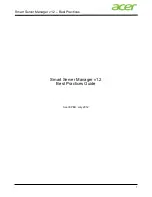
748
Chapter 33: Integrating J2EE and Java Elements in CFML Applications
Note:
You can use the direct reference method to get or set values in some classes that have
getProperty
and
setProperty
methods but do not conform fully to the JavaBean pattern. However,
you cannot use this technique for all classes that have
getProperty
and
setProperty
methods. For
example, you cannot directly reference any of the following standard Java classes, or classes derived
from them: Date, Boolean, Short, Integer, Long, Float, Double, Char, Byte, String, List, Array.
Calling nested objects
ColdFusion supports nested (scoped) object calls. For example, if an object method returns
another object and you must invoke a property or method on that object, you can use the
following syntax:
<cfset prop = myObj.X.Property>.
Similarly, you can use code such as the following CFScript line:
GetPageContext().include("hello.jsp?name=Bobby");
In this code, the ColdFusion
GetPageContext
function returns a Java PageContext object, and
the line invokes the PageContext object’s
include
method.
Creating and using a simple Java class
Java is a strongly typed language, unlike ColdFusion, which does not enforce data types. As a
result, there are some subtle considerations when calling Java methods. The following sections
create and use a Java class to show how to use Java effectively in ColdFusion pages.
The Employee class
The Employee class has four data members: FirstName and LastName are public, and Salary and
JobGrade are private. The Employee class has three overloaded constructors and a overloaded
SetJobGrade method.
Save the following Java source code in the file Employee.java, compile it, and place the resulting
Employee.class file in a directory that is specified in the classpath:
public class Employee {
public String FirstName;
public String LastName;
private float Salary;
private int JobGrade;
public Employee() {
FirstName ="";
LastName ="";
Salary = 0.0f;
JobGrade = 0;
}
public Employee(String First, String Last) {
FirstName = First;
LastName = Last;
Salary = 0.0f;
JobGrade = 0;
}
Summary of Contents for COLDFUSION MX 61-DEVELOPING COLDFUSION MX
Page 1: ...Developing ColdFusion MX Applications...
Page 22: ...22 Contents...
Page 38: ......
Page 52: ...52 Chapter 2 Elements of CFML...
Page 162: ......
Page 218: ...218 Chapter 10 Writing and Calling User Defined Functions...
Page 250: ...250 Chapter 11 Building and Using ColdFusion Components...
Page 264: ...264 Chapter 12 Building Custom CFXAPI Tags...
Page 266: ......
Page 314: ...314 Chapter 14 Handling Errors...
Page 344: ...344 Chapter 15 Using Persistent Data and Locking...
Page 349: ...About user security 349...
Page 357: ...Security scenarios 357...
Page 370: ...370 Chapter 16 Securing Applications...
Page 388: ...388 Chapter 17 Developing Globalized Applications...
Page 408: ...408 Chapter 18 Debugging and Troubleshooting Applications...
Page 410: ......
Page 426: ...426 Chapter 19 Introduction to Databases and SQL...
Page 476: ...476 Chapter 22 Using Query of Queries...
Page 534: ...534 Chapter 24 Building a Search Interface...
Page 556: ...556 Chapter 25 Using Verity Search Expressions...
Page 558: ......
Page 582: ...582 Chapter 26 Retrieving and Formatting Data...
Page 668: ......
Page 734: ...734 Chapter 32 Using Web Services...
Page 760: ...760 Chapter 33 Integrating J2EE and Java Elements in CFML Applications...
Page 786: ...786 Chapter 34 Integrating COM and CORBA Objects in CFML Applications...
Page 788: ......
















































